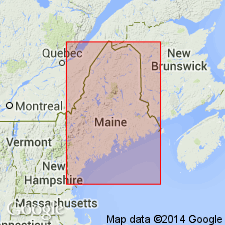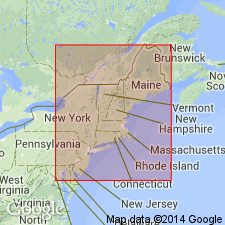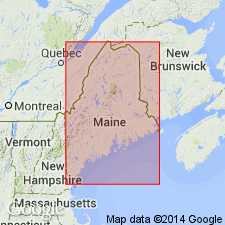
- Usage in publication:
-
- Katahdin granite
- Modifications:
-
- Principal reference
- Dominant lithology:
-
- Granite
- AAPG geologic province:
-
- New England province
Toppan, F.W., 1932, The geology of Maine: Union College, Department of Geology M.S. thesis, 141 p.
Summary:
Pg. 68-69. Katahdin granite. Lying on eastern boundary of Piscataquis County and extending into Penobscot County, western Maine, is a great mass of granite that represents a denuded batholith of which Mount Katahdin, 5,267 A.T., is most conspicuous feature. In hand specimen it is medium-coarse, even-grained granite tinted slightly pink by the orthoclase feldspar. Intrudes Ripogenous series (Silurian). [Age is Carboniferous(?). On the 1933 geol. map of Maine, by Arthur Keith, this granite is assigned to Carboniferous.]
Source: US geologic names lexicon (USGS Bull. 896, p. 1073-1074).

- Usage in publication:
-
- Katahdin Granite*
- Modifications:
-
- Revised
- Redescribed
- AAPG geologic province:
-
- New England province
Summary:
Katahdin Quartz Monzonite changed to Katahdin Granite to conform to the modern definition of granite.
Source: GNU records (USGS DDS-6; Reston GNULEX).

- Usage in publication:
-
- Katahdin Granite*
- Modifications:
-
- Overview
- Geochronologic dating
Summary:
Katahdin Granite underlies Mount Katahdin and neighboring peaks. The following considerations suggest that magmatism partly predated Acadian deformation: 1) Katahdin pluton truncates regional folds that deform rocks as young as Traveler Rhyolite (Emsian, 394-387 Ma); 2) Traveler Rhyolite, however, forms volcanic carapace of the pluton; 3) pluton itself shows no signs of tectonic deformation; 4) deformation within contact aureole appears less intense than outside aureole; and 5) isotopic ages from pluton are widely scattered and inconsistent with stratigraphic constraints. Loiselle and others (1983) reported a 207Pb/206Pb zircon age of 414 +/-4 Ma and a Rb/Sr whole rock age of 388 +/-5 Ma; Denning and Lux (1990) reported a 40Ar/39Ar biotite age of 400.1 +/-1.0 Ma.
Source: GNU records (USGS DDS-6; Reston GNULEX).
For more information, please contact Nancy Stamm, Geologic Names Committee Secretary.
Asterisk (*) indicates published by U.S. Geological Survey authors.
"No current usage" (†) implies that a name has been abandoned or has fallen into disuse. Former usage and, if known, replacement name given in parentheses ( ).
Slash (/) indicates name conflicts with nomenclatural guidelines (CSN, 1933; ACSN, 1961, 1970; NACSN, 1983, 2005, 2021). May be explained within brackets ([ ]).

